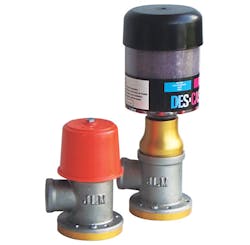ORAs Improve Filter Breathers
Breathers are usually considered a commodity item for most hydraulic systems. A breather lets ambient air be drawn into the reservoir whenever fluid level falls and lets air escape the reservoir as fluid level rises. Restricting the flow of exhaust air through the breather can cause pressure to build inside the reservoir.
More importantly, restricting the incoming airflow can cause a partial vacuum to occur in the space above the fluid in the reservoir. If the vacuum level gets high enough, and it doesn’t take much, it can starve the pump inlet. This, in turn, can lead to cavitation, which can rapidly and severely damage the pump.
Standard breathers don’t pose a huge threat to airflow. That’s because they consist of little more than a screen, so air can freely flow into and out of the reservoir. The problem is that they don’t offer much protection. When ambient air is drawn in, so is moisture and airborne dirt. Once these contaminants get into the reservoir, they can wreak havoc on hydraulic fluid and any component in the hydraulic system.
We’ve gotten smarter through the years, so most reservoir breathers include more sophisticated filters and even desiccant elements that trap dirt and moisture before they are drawn into the reservoir. But according to Dick Gangnon of JLM Systems Ltd., Richmond, B.C., Canada, even these newer filters have shortcomings
“Filter media [in filter breathers] work in both directions. Airborne contamination [including moisture] is removed from both the replacement air and the exhaust air,” Gangnon says. The end result is that the life and efficiency of the air filter is reduced because it needlessly filters the exhaust air.
“Oil mist, the outgoing contamination, is, by far, the most damaging contaminant [for the filter] and may remain unseen and unnoticed until oil droplets from the filter collect on the top of the reservoir,” Gangnon says. “At this point, the filter has been in failure mode for some time.”
Gangnon’s solution is to use an Oilmiser Reservoir Aspirator (ORA). The ORA is installed between a standard reservoir and filter breather. It has two airflow passageways, each with a check valve. The check valve in the inlet passage allows ambient air to enter the reservoir but prevents air in the reservoir from flowing out. The check valve in the other passageway does just the opposite. It lets air exhaust from the reservoir but blocks incoming ambient air.
The ORA comes in an array of sizes and configurations to serve a wide variety of applications, including a surface flange mount version with six holes in a 2.88-in. bolt circle and a female pipe bottom mount. Inlet and exhaust ports come in a variety of port sizes and thread configurations. The ports allow direct connection of a filter, or piping can be incorporated to draw air from a cleaner area when the reservoir is located in an extremely dirty or wet environment.
For more information on JLM’s Oilmiser Reservoir Aspirator, call (604) 521-3248 or visit www.oilmiser.com.


